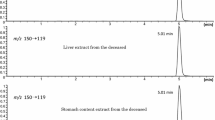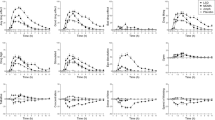Summary
Eighteen subjects with amphetamine psychosis were studied with respect to fluid balance, intensity and duration of psychotic symptoms, urinary and plasma amphetamine levels and the relative amounts of unchanged drug and metabolites in urine. On admission to hospital about half of the psychotic patients were dehydrated, the water lack being up to 6.7% of total body weight. The dehydrated subjects had lower renal clearances of amphetamine because of lower rates of urine production. As noted previously there was a strongly positive correlation between urinary pH and the half life (T 1/2) of plasma amphetamine, with an increase inT 1/2 of about 7 h for every unit increase in urinary pH. Patients with alkaline urine had intense psychoses lasting for about 4 1/2 days after the last dose of amphetamine. In patiens with acid urine, the psychotic symptoms were milder, and of about 2 days duration. No correlation was found between the degree of psychosis in different subjects and the plasma levels of the drug. — The ratio between the amounts of labelled metabolites and unchanged drug excreted in urine rose for each day after administration of3H-amphetamine, implying a slower excretion rate for the metabolites than for the parent drug. The relative proportion of metabolites was higher in patients with an alkaline urine, being more than 90% after the first day. — When amphetamine (200 mg i.v.) was given to nonpsychotic, dependent subjects, the peak plasma levels (mean 423 ng/ml) exceeded the highest levels observed during the first day in psychotic patients. However, no psychotic symptoms were observed in these subjects. The volumes of distribution calculated from the monoexponential elimination curves were higher than those previously reported in nondependent subjects. — With an alkaline urine a group of nonpsychotic amphetamine-dependent subjects had significantly longer plasmaT 1/2 (p<0.05) than a group of drug-naive control subjects. The results suggest that increased tissue binding may be a component in tolerance to amphetamine in dependent humans.
Similar content being viewed by others
References
Angrist, B.M., Schweitzer, J., Friedhoff, A.J., Gerhhon, S., Hekimian, L.J., Floyd, A.: The clinical symptomatology of amphetamine psychosis and its relationship to amphetamine levels in urine. Int. Pharmacopsychiat.2, 125–139 (1969).
Asatoor, A.M., Galman, B.R., Johnson, J.R., Milne, M.D.: The excretion of dexamphetamine and its derivatives. Brit. J. Pharmacol.24, 293–300 (1965).
Axelrod, J.: Studies on sympathomimetic amines. II. The biotransformation and physiological disposition of D-amphetamine, D-p-hydroxyamphetamine and D-methamphetamine. J. Pharm. exp. Ther.110, 315–326 (1954).
Änggård, E., Gunne, L.M.: Pharmacodynamic studies on amphetamine abusers; objectives and methods. In: Abuse of Central Stimulants. By Sjöqvist, F. and Tottie, M. (Eds). Stockholm: Almqvist and Wiksell 1969.
—— —— Niklasson, F.: Gas chromatographic determination of amphetamine in blood, tissue and urine. Scand. J. clin. Lab. Invest.26, 137–144 (1970).
Beckett, A.H., Rowland, M.: Urinary excretion kinetics of amphetamine in man. J. Pharm. Pharmacol.17, 628–639 (1965).
—— Salmon, J.A., Mitchard, M.: The relation between blood levels and urinary excretion of amphetamine under controlled acidic and under fluctuating urinary pH values using (14C) amphetamine. J. Pharm. Pharmacol.21, 251–258, 1969.
Bland, J.H.: Disturbances of fluid balance. Philadelphia & London: W.B Saunders, Co. 1956.
Bonhoff, G., Laurenz, H.: Über Weckamine (Pervitin und Benzedrin) Monogr. Gesamtgeb. Neurol. Psychiat.77, 1–144 (1959).
Connell, P.H.: Amphetamine psychosis, Maudsley Monograph No. 5. London: Chapman & Hall, 1958.
Davis, J.M., Kopin, E.J., Axelrod, J.: Effects of urinary pH on plasma levels and metabolism of3H-amphetamine in man. Pharmacologist11, 2 1969.
Ellison, T., Siegel, M., Silverman, A.G., Okun, R.: Comparative metabolism of d,l-3H-amphetamine hydrochloride in tolerant and nontolerant cats. Proc. Western Pharmacol. Soc.11, 75–77 (1968).
Franksson, G., Änggård, E.: The plasma protein binding of amphetamine, catecholamines and related compounds. Acta. pharmacol. Toxicol.28, 209–214 (1970).
Goldberg, L.: Drug abuse in Sweden. Bull. on Narc.,2, 9–36 (1968).
Griffith, J.D., Cavanaugh, J.H., Held, J., Oates, J.A.: Experimental psychosis induced by the administration of d-amphetamine. In: Amphetamines and Related Compounds. By E. Costa and S. Garattini. New York: Raven Press 1970.
Jönsson, L.E., Sjöström, K.: A rating scale for evaluation of the clinical course and symptomatology in amphetamine psychosis. Brit. J. Psych. In press 1970.
—— Gunne, L.M., Änggård, E.: Effects of alphamethyltyrosine in amphetamine-dependent subjects. Pharmacol. Clin.2, 27–29 (1969).
Kalant, O.J.: The amphetamines: Toxicity and addiction. Alcoholism and drug addiction research foundation of Ontario. Toronto 1966.
Kato, R., Vassanelli, P.: Induction of increased meprobamate metabolism in rats pretreated with some neurotropic drugs. Biochem. Pharmac.11, 779–794 (1962).
—— Chiesari, E.: Increase of pentobarbitone metabolism induced in rats pretreated with some centrally acting compounds. Brit. J. Pharmac.18, 29–33 (1962).
—— —— Vassanelli, P.: Further studies on the inhibition and stimulation of microsomal drug metabolizing enzymes of rat liver by various compounds. Biochem. Pharmac.13, 69–83 (1964).
Lewander, T.: Urinary excretion and tissue levels of catecholamines during chronic amphetamine intoxication. Psychopharmacologica (Berl.)13, 394–407 (1968).
-- On the presence of p-hydroxynorefedrine in the rat brain and heart in relation to changes in catecholamine levels after administration of amphetamine. Acta pharmacol. Toxicol. In press 1971.
Maickel, R.R., Cox, R.H. Jr., Miller, F.P., Segal, D.S., Rusell, R.W.: Correlation between brain levels of drugs with their behavioral effects. J. Pharmacol. exp. Ther.165, 216–224 (1969).
Norman, J., Shea, J.: Acute hallucinosis as a complication of addiction to amphetamine sulfate. New Engl. J. Med.233, 270–271 (1945).
Rowland, M.: Amphetamine blood and urine levels in man. J. Pharm. Soc.,58, 508–509 (1969).
Siegel, M., Ellison, T., Silverman, A.G., Okun, R.: Tissue distribution of d,l-3H-amphetamine HCl in tolerant and nontolerant cats. Proc. Western Pharmacol. Soc.11, 90–94 (1968).
Author information
Authors and Affiliations
Rights and permissions
About this article
Cite this article
Änggård, E., Gunne, L.M., Jönsson, L.E. et al. Pharmacokinetic and clinical studies on amphetamine dependent subjects. Eur J Clin Pharmacol 3, 3–11 (1970). https://doi.org/10.1007/BF00560284
Received:
Issue Date:
DOI: https://doi.org/10.1007/BF00560284




